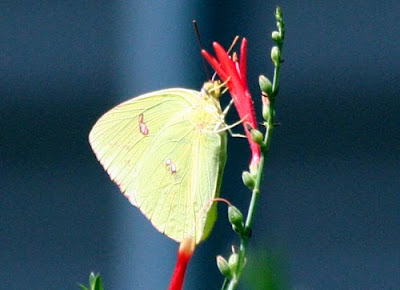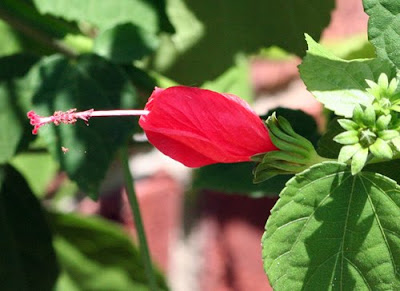It's been an interesting but frustrating, hopeful but finally depressing week in the garden.
On Monday, we did finally get some of the rain that had been making the rounds in the area. A total of 1.1" fell and was greatly appreciated. Showers continued to flirt with us for much of the week, but ultimately they all passed us by to dump their bounty on some other fortunate plot.
Before the rains on Monday, we reached the 100 degree mark for the second time this summer - the first time had been the day before. In fact, we passed it by a smidge, topping out at 101 degrees. Forecasters are saying we might reach the century mark again over the weekend.
Sigh.
The trees in my yard are beginning to drop some leaves now, most notably the apple tree. It's one way of reducing loss of water in the heat and is just another sign that autumn really is on its way.
So what about that fall veggie garden? Well, we did get some replacement tomato plants for the ones we killed a couple of weeks ago. These, too, are 'Champion II' plants and I got the three of them into the ground this week. I dug a big hole for each plant, filled the hole with water, and then stripped off the lower leaves of the plants and buried them with just a few inches showing aboveground. Lastly, I spread a couple of inches of mulch around each plant and watered the mulch and the plant again. Today, I plan to finish mulching the entire bed and put the shade cloth up to give the plants some protection.

Here's one of the little plants after I got it into the ground, and...

...here's all three lined up in the bed. Not much to look at now but I have high hopes for them!
Looking around the yard this week, the falling leaves are not the only indication that autumn will soon be here. The fall berries are ripening.

As soon as the pokeweed berries turn shiny purple black, they get gobbled up by the birds. Among all the green berries here, you can see a few twigs where the fruit has ripened but most of those have very few berries left on them.

The munching of the elderberries is even more pronounced and, in some places, there are few berries left.

I didn't plant the elderberries and pokeweed, the birds did, but I did plant this white beautyberry which is now heavy with berries. Beautyberries typically do not get eaten by the birds until the softer berries like the two above are exhausted. They may last well into the winter. Last year, I was interested to note that the birds seemed to prefer the white beautyberries to the purple ones. The white ones disappeared long before the purple, but I have no explanation for why that should be.

Nearby, a purple beautyberry's berries are not quite ripe yet.
Long-time readers of the blog may remember my documenting my big front yard project last year. On the
first of each month, I showed you pictures of the beds there. As a refresher, here's the way they looked on the first of August last year.

Here's a view from the driveway, looking toward the entry. Those are Blackfoot daisies that are spilling over.

Here's the mid-point of that front bed that was dominated by the rampant potato vine.

And here's the view from the south side, looking back across the front.
Well, in evaluating the beds during last winter, I decided that I had made just about every mistake in the book, which, truthfully, is just about par for the course of my gardening efforts. Several plants were too big for their space and nearly all the plants went down during the winter (though they came back in spring) leaving the front of the house looking rather drab and forlorn during that season.
I subsequently moved some of the plants including the 'Big Momma' Turk's caps that obviously wanted more room and the purple fountain grass that was poorly placed. I also moved the 'Tropicannas' to another bed where I thought they might be happier. I lost the Australian rosemary and some bat-face cupheas to the winter cold, which was a disappointment. In the spring, I added some viburnums, one of which has done very well, the other two not so well. I also shifted some of the other plants around and added some daylilies - just because I needed some place to plant them.
And that brings us up to this week. The beds were an overgrown mess. (Sorry, I neglected to take "before" pictures so you'll just have to take my word for that.) Drastic action was called for, so out came the Felcos and I went to work. Here's how the beds looked when I finished.

There's not much left at the entry. As for that 'Texas Star' hibiscus, it is now abundantly clear that it, too, needs more room. I'll probably try lifting it and moving it to another location this winter.

In the mid-front section, there are some salvias, the viburnums, some phlox and buddleias, but it all looks pretty sad.

Looking from the south back across the front is pretty depressing.
So, here I go again. I've got my work cut out for me. More research and perhaps professional advice is obviously required. I need some plants that will provide winter interest as well as habitat plants for the birds and butterflies through other seasons of the year. Overall, I still need to achieve that cottage garden look which I like and which goes with the style of my house. At least this time the beds are already in place so I don’t have to start from scratch.
Oh, well, another opportunity to learn from my mistakes.


















































